Lucrezia Borgia
Lucrezia Borgia (Italian pronunciation: [luˈkrɛttsja ˈbɔrdʒa]; Valencian: Lucrècia Borja [luˈkrɛsia ˈbɔɾdʒa]; 18 April 1480 – 24 June 1519) was a Spanish-Italian noblewoman of the House of Borgia who was the daughter of Pope Alexander VI and Vannozza dei Cattanei. She reigned as the Governor of Spoleto, a position usually held by cardinals, in her own right.
| Lucrezia Borgia | |
|---|---|
_-_Lucrezia_Borgia%2C_Duchess_of_Ferrara_-_Google_Art_Project.jpg) The only confirmed Lucrezia portrait painted from life (attributed to Battista Dossi, c. 1519, National Gallery of Victoria) | |
| Duchess-consort of Ferrara, Modena, and Reggio | |
| Tenure | 25 January 1505 – 24 June 1519 |
| Duchess consort of Bisceglie, Princess consort of Salerno | |
| Tenure | 1498 – 1500 |
| Governor of Spoleto | |
| Tenure | 1499 – 1500 |
| Lady of Pesaro and Gradara, Countess of Catignola | |
| Tenure | 12 June 1492 – 20 December 1497 |
| Born | 18 April 1480 Subiaco |
| Died | 24 June 1519 (aged 39) Ferrara |
| Burial | Convent of Corpus Domini |
| Spouse | Giovanni Sforza (m. 1493; annulled 1497) Alfonso of Aragon (m. 1498; died 1500) Alfonso d'Este (m. 1502) |
| Issue | Rodrigo of Aragon Alessandro d'Este (1505-1505) Ercole II d'Este, Duke of Ferrara Ippolito II d'Este Alessandro d'Este (1514-1516) Leonora d'Este Francesco d'Este, Marchese di Massalombarda Isabella Maria d'Este |
| House | Borgia |
| Father | Pope Alexander VI |
| Mother | Vannozza dei Cattanei |
Her family arranged several marriages for her that advanced their own political position including Giovanni Sforza, Lord of Pesaro and Gradara, Count of Catignola; Alfonso of Aragon, Duke of Bisceglie and Prince of Salerno; and Alfonso I d'Este, Duke of Ferrara. Tradition has it that Alfonso of Aragon was an illegitimate son of the King of Naples and that her brother Cesare Borgia may have had him murdered after his political value waned.
Rumors about her and her family cast Lucrezia as a femme fatale, a role in which she has been portrayed in many artworks, novels and films.
Early life
Lucrezia Borgia was born on 18 April 1480 at Subiaco, near Rome.[1] Her mother was Vannozza dei Cattanei, one of the mistresses of Lucrezia's father, Cardinal Rodrigo de Borgia (later Pope Alexander VI).[2] During her early life, Lucrezia Borgia's education was entrusted to Adriana Orsini de Milan, a close confidant of her father. Her education would primarily take place in the Piazza Pizzo de Merlo, a building adjacent to her father's residence. Unlike most educated women of her time, for whom convents were the primary source for knowledge, her education came from within the sphere of intellectuals in the court and close relatives, and it included a solid grounding in the Humanities, which the Catholic Church was reviving at the time. She was a thoroughly accomplished princess, fluent in Spanish, Catalan, Italian, and French, which prepared her for advantageous marriage to any European monarch or prince, and literate in both Latin and Greek. She would also become proficient in the lute, poetry, and oration. The biggest testament to her intelligence is her capability in administration, as later on in life she took care of Vatican City correspondence and governance of Ferrara.
Marriages
First marriage: Giovanni Sforza (Lord of Pesaro and Gradara)
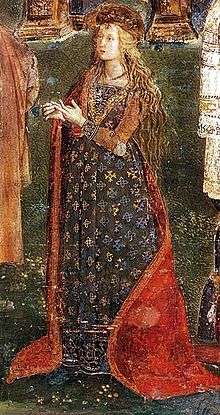
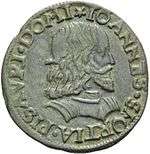
On 26 February 1491, a matrimonial arrangement was drawn up between Lucrezia and the Lord of Val D'Ayora, in the kingdom of Valencia, Don Cherubino Joan de Centelles, which was annulled less than two months later in favour of a new contract engaging Lucrezia to Don Gaspare Aversa, count of Procida.[3] When Rodrigo became Pope Alexander VI, he sought to be allied with powerful princely families and founding dynasties of Italy. He therefore called off Lucrezia's previous engagements and arranged for her to marry Giovanni Sforza, a member of the House of Sforza who was Lord of Pesaro and titled Count of Catignola.[4] Giovanni was an illegitimate son of Costanzo I Sforza and a Sforza of the second rank. He married Lucrezia on 12 June 1493 in Rome.[2]
Before long, the Borgia family no longer needed the Sforzas, and the presence of Giovanni Sforza in the papal court was superfluous. The Pope needed new, more advantageous political alliances, so he might have covertly ordered the execution of Giovanni: the generally accepted version is that Lucrezia was informed of this by her brother Cesare, and she warned her husband, who fled Rome.[5]
Alexander asked Giovanni's uncle, Cardinal Ascanio Sforza, to persuade Giovanni to agree to an annulment of the marriage. Giovanni refused and accused Lucrezia of paternal incest.[6] The pope asserted that his daughter's marriage had not been consummated and was thus invalid. Giovanni was offered her dowry in return for his cooperation.[7] The Sforza family threatened to withdraw their protection should he refuse. Giovanni finally signed confessions of impotence and documents of annulment before witnesses.
Alleged affair with Perotto
There has been speculation that during the prolonged process of the annulment, Lucrezia consummated a relationship with someone, perhaps Alexander's chamberlain Pedro Calderon, also named Perotto.[8] In any case, families hostile to the Borgias would later accuse her of being pregnant at the time her marriage was annulled for non-consummation. She is known to have retired to the convent of San Sisto in June 1497 to await the outcome of the annulment proceedings, which were finalized in December of the same year. The bodies of Pedro Calderon[8] and a maid, Pantasilea, were found in the Tiber in February 1498. In March 1498, the Ferrarese ambassador claimed that Lucrezia had given birth, but this was denied by other sources. A child was born, however, in the Borgia household the year before Lucrezia's marriage to Alfonso of Aragon. He was named Giovanni but is known to historians as the "Infans Romanus".
In 1501, two papal bulls were issued concerning the child, Giovanni Borgia. In the first, he was recognized as Cesare's child from an affair before his marriage. The second, contradictory, bull recognized him as the son of Pope Alexander VI. Lucrezia's name is not mentioned in either, and rumors that she was his mother have never been proven. The second bull was kept secret for many years, and Giovanni was assumed to be Cesare's son. This is supported by the fact that in 1502 he became Duke of Camerino, one of Cesare's recent conquests, hence the natural inheritance of the Duke of Romagna's oldest son. Giovanni went to stay with Lucrezia in Ferrara after Alexander's death, where he was accepted as her half-brother.[9]
Second marriage: Alfonso d'Aragon (Duke of Bisceglie and Prince of Salerno)
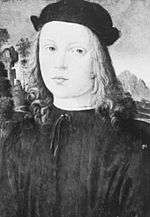
Following her annulment from Sforza, Lucrezia was married to the Neapolitan Alfonso of Aragon, the half-brother of Sancha of Aragon who was the wife of Lucrezia's brother Gioffre Borgia. The marriage was a short one.[2]
They were married in 1498, making Lucrezia the Duchess consort of Bisceglie and Princess consort of Salerno. Lucrezia—not her husband—was appointed governor of Spoleto in 1499; Alfonso fled Rome shortly afterwards but returned at Lucrezia's request, only to be murdered in 1500.[10]
It was widely rumored[11] that Lucrezia's brother Cesare was responsible for Alfonso's death, as he had recently allied himself (through marriage) with France against Naples. Lucrezia and Alfonso had one child, Rodrigo of Aragon, who was born in 1499 and predeceased his mother in August 1512 at the age of 12.[2]
Third marriage: Alfonso d'Este (Duke of Ferrara)
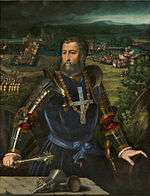
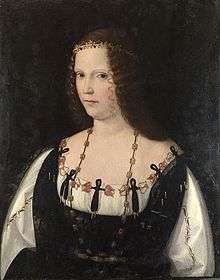
After the death of Lucrezia's second husband, her father, Pope Alexander VI, arranged a third marriage. She then married Alfonso I d'Este, Duke of Ferrara, in early 1502 in Ferrara. She had eight children during this marriage and was considered a respectable and accomplished Renaissance duchess, effectively rising above her previous reputation and surviving the fall of the Borgias following her father's death.[13]
Neither partner was faithful: beginning in 1503, Lucrezia enjoyed a long relationship with her brother-in-law, Francesco II Gonzaga, Marquess of Mantua.[14][15] Francesco's wife was the cultured intellectual Isabella d'Este, the sister of Alfonso, to whom Lucrezia had made overtures of friendship to no avail. The affair between Francesco and Lucrezia was passionate, more sexual than sentimental as can be attested in the fevered love letters the pair wrote one another.[16] It has been claimed that the affair ended when Francesco contracted syphilis and had to end sexual relations with Lucrezia.[17] This last assertion is problematic as Francesco had contracted syphilis before 1500 as it was known that he passed the disease onto his eldest son Federico Gonzaga who was born in 1500. Francesco did not meet Lucrezia until 1502.[18]
Lucrezia also had a love affair with the poet Pietro Bembo during her third marriage. Their love letters were deemed "The prettiest love letters in the world" by the Romantic poet Lord Byron when he saw them in the Ambrosian Library of Milan on 15 October 1816.[19][20] On the same occasion Byron claimed to have stolen a lock of Lucrezia's hair – "the prettiest and fairest imaginable"[20] – that was also held there on display.[21][22][23]
Lucrezia met the famed French soldier, the Chevalier Bayard while the latter was co-commanding the French allied garrison of Ferrara in 1510. According to his biographer, the Chevalier became a great admirer of Lucrezia's, considering her a "pearl on this Earth".[24]
After a long history of complicated pregnancies and miscarriages, on 14 June 1519 Lucrezia gave birth to her tenth child, named Isabella Maria in honour of Alfonso's sister Isabella d'Este. The child was sickly and – fearing she would die unbaptised – Alfonso ordered her to be baptised straightaway with Eleonora della Mirandola and Count Alexandro Serafino as godparents.
Lucrezia had become very weak during the pregnancy and fell seriously ill after the birth. After seeming to recover for two days, she worsened again and died on 24 June the same year. She was buried in the convent of Corpus Domini.[25]
Appearance
.png)
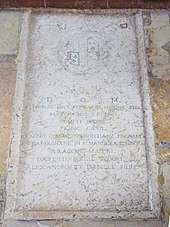
She is described as having heavy blonde hair that fell past her knees, a beautiful complexion, hazel eyes that changed color, a full, high bosom, and a natural grace that made her appear to "walk on air".[26] These physical attributes were highly appreciated in Italy during that period. Another description said, "her mouth is rather large, the teeth brilliantly white, her neck is slender and fair, and the bust is admirably proportioned."[27]
One painting, Portrait of a Youth by Dosso Dossi at the National Gallery of Victoria, was identified as a portrait of Lucrezia in November 2008.[28][29][30][31][32] This painting may be the only surviving formal portrait of Lucrezia Borgia; however, doubts have been cast on that attribution.[33] Several other paintings, such as Veneto's fanciful portrait, have also been said to depict her, but none have been accepted by scholars at present.
According to Mandell Creighton in his History of the Papacy "Lucrezia ... was personally popular through her beauty and her affability. Her long golden hair, her sweet childish face, her pleasant expression and her graceful ways, seem to have struck all who saw her."
Rumours
Several rumours have persisted throughout the years, primarily speculating as to the nature of the extravagant parties thrown by the Borgia family. One example is the Banquet of Chestnuts. Many of these concern allegations of incest, poisoning, and murder on her part; however, no historical basis for these rumours has ever been brought forward beyond allegations made by rival parties.
- It is rumoured that Lucrezia was in possession of a hollow ring that she used frequently to poison drinks.[34][35]
- An early 20th-century painting by Frank Cadogan Cowper that hangs in the London art gallery, Tate Britain, portrays Lucrezia taking the place of her father, Pope Alexander VI, at an official Vatican meeting. This apparently documents an actual event, although the precise moment depicted (a Franciscan friar kissing Lucrezia's feet) was invented by the artist.[36]
Issue
Lucrezia was mother to seven or eight known children:
- Rodrigo of Aragon (1 November 1499 – August 1512). Son by Alfonso of Aragon;
- A stillborn daughter (1502), First child by d'Este;
- Alessandro d'Este (1505-1505);
- Ercole II d'Este, Duke of Ferrara (5 April 1508 – 3 October 1559);
- Ippolito II d'Este (25 August 1509 – 1 December 1572). Archbishop of Milan and later Cardinal;
- Alessandro d'Este (1514–1516).;
- Leonora d'Este (3 July 1515 – 15 July 1575), a nun and composer;
- Francesco d'Este, Marquess of Massalombarda (1 November 1516 – 2 February 1578);
- Isabella Maria d'Este (born and died on 14 June 1519).[37] Complications at birth caused the death of Lucrezia ten days later.
Giovanni Borgia, "infans Romanus" ("Child of Rome", c. 1498–1548) had his paternity acknowledged by both Alexander and Cesare in two separate Papal bulls, but it was rumoured that he was the child of Lucrezia and Perotto. The child (identified in later life as Lucrezia's half-brother) was most likely the result of a liaison between Rodrigo Borgia (Pope Alexander VI, Lucrezia's father) and an unknown mistress and was not Lucrezia's child.[38]
At least one biographer (Maria Bellonci) claims that Lucrezia gave birth to three more children, one by Alfonso of Aragon and two by Alfonso d'Este, who did not survive infancy. She is also thought to have had at least four miscarriages.[39]
Biographies
- Lucrezia Borgia: Life, Love And Death In Renaissance Italy by Sarah Bradford; Viking 2004; ISBN 0-670-03353-7
- Lucrezia Borgia: A Biography by Rachel Erlanger; 1978; ISBN 0-8015-4725-3
- Lucrezia Borgia by Maria Bellonci; Phoenix 2002; ISBN 978-1-84212-616-5
- The Borgias (1971) by Michael Mallett
- Lucretia Borgia (1874?) by Ferdinand Gregorovius (Author); translated in 1903 by John Leslie Garner (Translator)
- The Borgias by Christopher Hibbert; Constable 2011; ISBN 978-1-84901-994-1
- The Borgias: History's Most Notorious Dynasty by Mary Hollingsworth; Quercus 2011; ISBN 978-0-85738-916-9
In fiction
- Blood And Beauty by Sarah Dunant; ISBN 1-443-40644-9; ISBN 978-1-44340-644-4; Harper Collins Publishers Ltd | July 8, 2013 |
- The Vatican Princess by C.W. Gortner; released Feb. 2016
- In the Name of the Family by Sarah Dunant; ISBN 978-1-84408-746-4; Virago Press 2017
- The Pope’s Daughter by Dario Fo, translated from Italian by Antony Shugaar; ISBN 978-1-60945-274-2. Translation copyright (c) 2015 by Europa Editions
Treatments and references
Literature and opera
- Victor Hugo's 1833 stage play Lucrèce Borgia, loosely based on the stories of Lucrezia, was transformed into a libretto by Felice Romani for Donizetti's opera, Lucrezia Borgia (1834), first performed at La Scala, Milan, 26 December 1833.[40]
- F. M. Klinger´s 1791 novel Fausts Leben, Thaten und Höllenfahrt features an episode in which the Borgias figure, including an affair between Faust and Lucrezia.
- Rafael Sabatini wrote the 1912 non-fiction book, The Life of Cesare Borgia,[41] that attempts to treat the Borgias historically.
- The 1947 historical novel Prince of Foxes by Samuel Shellabarger describes the adventures of the fictional Andrea Orsini, a captain in the service of Cesare Borgia, during his conquest of the Romagna; it was made into a film of the same name in 1949, starring Orson Welles and Tyrone Power.[42]
- Jean Plaidy's two 1958 novels, Madonna of the Seven Hills and Light on Lucrezia, follow the story of Lucrezia and her entanglement with her father and brothers.[43]
- Lucrezia, Cesare and Alexander play key roles in Cecelia Holland's 1979 historical novel City of God: A Novel of the Borgias.[44]
- In Roberta Gellis's 2003 novel Lucrezia Borgia and the Mother of Poisons (ISBN 9780765306616), Alfonso d'Este of Ferrara accuses Lucrezia of murder, and she must solve the crime and expose the true murderer.
- The Dutch writer Louis Couperus published a story called "Lucrezia" in 1920 and takes place between the death of her second husband and the marriage of her third.[45]
Film and television
- Lucrezia (Estelle Taylor) and Cesare (Warner Oland) Borgia are the major antagonists in Alan Crosland's 1926 silent film Don Juan, starring John Barrymore.[46]
- Lucrezia is the subject of Abel Gance's film Lucrezia Borgia (1935)[47] and of a 1953 French film, played by Martine Carol.[48]
- Lucrezia is the Bride of Vengeance (1949), played by Paulette Goddard, with Macdonald Carey in the role of Cesare Borgia, and John Lund playing Alfonso d'Este (Duke of Ferrara).[49][50]
- In Walerian Borowczyk's 1973 feature film Immoral Tales, Lucrezia is played by Florence Bellamy.[51]
- In the 1981 BBC series, The Borgias, Lucrezia was played by Anne-Louise Lambert.[52]
- In the 1982 feature film The Secret Nights of Lucrezia Borgia of director Roberto Bianchi Montero, Lucrezia is played by Sirpa Lane.[53]
- She is featured as a major plot point in the 1994 TV movie The Shaggy Dog.[54] A portrait of her, along with a display case of her rings are featured in a local museum along with a legend that she had written spells to turn her lovers into dogs. The legend is revealed to be true as the main character accidentally casts one on himself while holding one of her rings and reading its inscription.
- She is played by Holliday Grainger in the 2011–2013 Showtime/Bravo TV series The Borgias, which explores a theme of incest with Cesare, despite lack of historical evidence for such events.[55] Her character is portrayed not as a ruthless murderer, but initially as a compassionate and sweet young girl who suffers from her family's ambitions, both struggling against and eventually aiding them.
- In the Canal+ television series Borgia, Lucrezia is portrayed by German actress Isolda Dychauk.[56]
- In the video game Assassin's Creed: Brotherhood, Lucrezia is again in an incestuous relationship with her brother Cesare and is kidnapped by Ezio Auditore during the course of the story.[57]
See also
- Castello Borgia
- Felice della Rovere
- Route of the Borgias
References
- Sarah Bradford: Lucrezia Borgia, Penguin Group, 2004, p. 16
- "Lucrezia Borgia, Predator or Pawn?". 17 January 2017. Retrieved 15 April 2017.
- Bellonci, Maria (2000). Lucrezia Borgia. London: Phoenix Press. p. 18. ISBN 1-84212-616-4.
- Bellonci, Maria (2000). Lucrezia Borgia. London: Phoenix Press. p. 23. ISBN 1-84212-616-4.
- Bellonci, Maria (2003). Lucrezia Borgia. Milan: Mondadori. pp. 121–122. ISBN 978-88-04-45101-3.
- Bellonci, Maria (2003). Lucrezia Borgia. Milan: Mondadori. pp. 139–141. ISBN 978-88-04-45101-3.
- {Some sources state that Giovanni returned the dowry. See, Durant, Will. "The Renaissance" Simon and Schuster (1953), page 429, ISBN 0-671-61600-5. See also Bradford, Sarah, "Lucrezia Borgia: Life, Love and Death in Renaissance Italy" Penguin Books (2005), Part 1, Ch. 3}
- Thurmel, Joseph (1923). Le Journal de Jean Burchard, Évêque et Cérémoniaire au Vatican. Paris: Les Éditions Reider. p. 328.
- Lucas, Emma (2014). Lucrezia Borgia. New World City.
- James A. Patrick, Renaissance and Reformation, Volume 1, Marshall Cavendish, 2007, p. 124
- Bradford, Sarah (2005). Lucrezia Borgia. La storia vera. Milan: Mondadori. pp. 85–88. ISBN 88-04-55627-7.
- Bellonci, Maria (2003). Lucrezia Borgia. Milan: Mondadori. p. 613. ISBN 978-88-04-45101-3.
- Roberto Gervaso, I Borgia, Milano, Rizzoli, 1977, p. 362, pp. 375–380.
- Lucrezia Borgia: Life, Love and Death in Renaissance Italy, Sarah Bradford, Viking, 2004
- David Jays. "Observer review: Lucrezia Borgia by Sarah Bradford". the Guardian. Retrieved 22 January 2015.
- Marek, pp.166–67
- Marek (1976) p. 169
- P., Cockram, Sarah D. (2013). Isabella d'Este and Francesco Gonzaga : power sharing at the Italian Renaissance Court. Farnham: Ashgate Publishing Ltd. ISBN 9781409448310. OCLC 855504802.
- Viragos on the march, The Spectator, 25 June 2005, by Ian Thomson, a review of Viragos on the march by Gaia Servadio. I. B. Tauris, ISBN 1-85043-421-2.
- Pietro Bembo: A Renaissance Courtier Who Had His Cake and Ate It Too, Ed Quattrocchi, Caxtonian: Journal of the Caxton Club of Chicago, Volume XIII, No. 10, October 2005.
- The Byron Chronology: 1816–1819 – Separation and Exile on the Continent.
- Byron by John Nichol.
- Letter to Augusta Leigh, Milan, 15 October 1816. Lord Byron's Letters and Journals, Chapter 5: Separation and Exile Archived 9 May 2008 at the Wayback Machine.
- Shellabarger, Samuel (1971). The Chevalier Bayard. eNet Press. p. 165.
- "Ferrara 2002 Anno di Lucrezia Borgia". Comune di Ferrara. Archived from the original on 16 June 2009.
- George R. Marek The Bed and the Throne: the Life of Isabella d'Este, Harper & Row, 1976, ISBN 978-0-06-012810-4 p. 142
- The Times Arts section page 14, 31 January 2011
- NGV's Renaissance mystery woman revealed, The Age, 25 November 2008, retrieved on 25 November 2008.
- Only known painting of Lucrezia Borgia discovered in Australian gallery The Times, London, 25 November 2008
- Infamous Renaissance woman subject of mystery portrait – Australian Broadcasting Corporation 26 November 2008, retrieved on 26 November 2008.
- Gallery unveils portrait of infamy, The Sydney Morning Herald, 26 November 2008, retrieved on 26 November 2008.
- Portrait of Renaissance femme fatale Lucrezia Borgia found at NGV, The Age, 26 November 2008, retrieved on 26 November 2008.
- Art detective says the brother did it, The Age, 27 November 2008
- Lucretia Borgia | guardian.co.uk:Philip Pank (5 February 2002).
- BBC – h2g2 – A Brief History of Poisoning, 28 July 2005.
- "'Lucretia Borgia Reigns in the Vatican in the Absence of Pope Alexander VI', Frank Cadogan Cowper – Tate". Tate. Retrieved 22 January 2015.
- Gregorovius, Ferdinand (14 August 2012). Lucrezia Borgia. p. 292. ISBN 9783954554195.
- Sarah Bradford: Lucrezia Borgia, Penguin Group, 2004, p. 68 and 114
- Bradford, Sarah (2005). Lucrezia Borgia: Life, Love and Death in Renaissance Italy. Penguin Books.
- Ashbrook, William and Sarah Hibberd (2001), in Holden, Amanda (Ed.), The New Penguin Opera Guide, New York: Penguin Putnam, p. 234. ISBN 0-14-029312-4.
- Prince of Foxes at the TCM Movie Database
- "A Novel of the Borgias". Penguin Random House. Retrieved 5 April 2019.
- Maclaine, David. "City of God by Cecelia Holland". Historicalnovels.info. Retrieved 5 September 2014.
- Stapert-Eggen, Marijke (1992). Repertorium Louis Couperus (in Dutch). Amsterdam: Overzicht. p. 133.
- Don Juan at the American Film Institute Catalog
- Keser, Robert (2 July 2001). "Behind the Brocade: Abel Gance's Lucrezia Borgia". Bright Lights Film Journal. Retrieved 5 April 2019.
- Lucrèce Borgia at the TCM Movie Database
- Crowther, Bosley (7 April 1949). "THE SCREEN IN REVIEW; Paulette Goddard, Macdonald Carey Play Borgias in 'Bride of Vengeance,' at Paramount". The New York Times. Retrieved 20 January 2018.
- Denton, C. S. (29 July 2016). Ruthless Rulers: The Real Lives of Europe's Most Infamous Tyrants. Arcturus Publishing. p. 473. ISBN 9781784285241.
- Immoral Tales at AllMovie
- Musel, Robert (7 October 1981). "'The Borgias' -- new BBC TV series a study in harsh reality". United Press International. Retrieved 5 April 2019.
- Thrower, Stephen (1999). Beyond terror: the films of Lucio Fulci. FAB Press. p. 291. ISBN 9780952926054.
- "John Leonard's TV notes". New York. 14 November 1994.
- Wagner, Curt (28 April 2013). "Francois Arnaud talks sibling love in 'The Borgias'". Chicago Tribune. Retrieved 5 April 2019.
- "An Interview With Isolda Dychauk". The Borgia Bull. 3 May 2013. Retrieved 5 April 2019.
- "Cesare and Lucrezia Borgia ewwww (minor spoilers)". GameSpot. Retrieved 5 April 2019.
External links
| Wikimedia Commons has media related to Lucrezia Borgia. |
Lucrezia Borgia House of Borgia Born: 18 April 1480 Died: 24 June 1519 | ||
| Royal titles | ||
|---|---|---|
| Vacant Title last held by Maddalena Gonzaga |
Lady consort of Pesaro and Gradara 12 June 1492 – 20 December 1497 |
Vacant Title next held by Ginevra Tiepolo |
| Vacant Title last held by Eleanor of Naples |
Duchess consort of Ferrara, Modena and Reggio 25 January 1505 – 24 June 1519 |
Vacant Title next held by Renée of France |